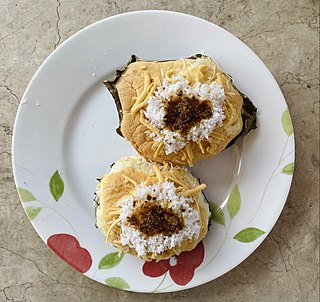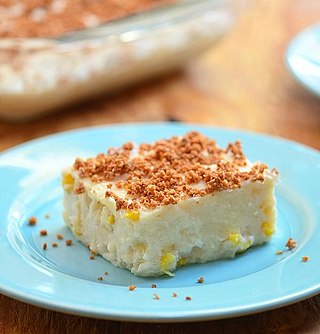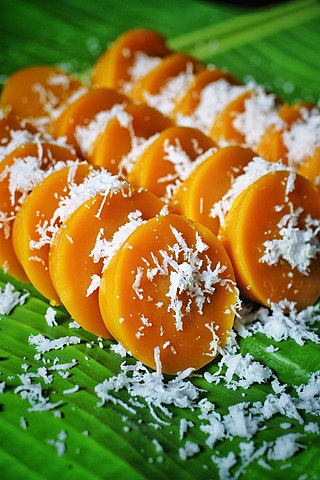
Glutinous rice is a type of rice grown mainly in Southeast and East Asia, and the northeastern regions of South Asia, which has opaque grains, very low amylose content, and is especially sticky when cooked. It is widely consumed across Asia.

Filipino cuisine is composed of the cuisines of more than a hundred distinct ethnolinguistic groups found throughout the Philippine archipelago. A majority of mainstream Filipino dishes that compose Filipino cuisine are from the food traditions of various ethnolinguistic groups and tribes of the archipelago, including the Ilocano, Pangasinan, Kapampangan, Tagalog, Bicolano, Visayan, Chavacano, and Maranao ethnolinguistic groups. The dishes associated with these groups evolved over the centuries from a largely indigenous base shared with maritime Southeast Asia with varied influences from Chinese, Spanish, and American cuisines, in line with the major waves of influence that had enriched the cultures of the archipelago, and adapted using indigenous ingredients to meet local preferences.

Bibingka commonly refers to a type of baked rice cake from the Philippines that is traditionally cooked in a terracotta oven lined with banana leaves and is usually eaten for breakfast or as merienda especially during the Christmas season. It is also known as bingka in the Visayas and Mindanao islands.

A rice cake may be any kind of food item made from rice that has been shaped, condensed, or otherwise combined into a single object. A wide variety of rice cakes exist in many different cultures in which rice is eaten. Common variations include cakes made with rice flour, those made from ground rice, and those made from whole grains of rice compressed together or combined with some other binding substance.

Kue is an Indonesian bite-sized snack or dessert food. Kue is a fairly broad term in Indonesian to describe a wide variety of snacks including cakes, cookies, fritters, pies, scones, and patisserie. Kue are made from a variety of ingredients in various forms; some are steamed, fried or baked. They are popular snacks in Indonesia, which has the largest variety of kue. Because of the countries' historical colonial ties, Koeé (kue) is also popular in the Netherlands.

Suman, or budbud, is an elongated rice cake originating in the Philippines. It is made from glutinous rice cooked in coconut milk, often wrapped in banana leaves, coconut leaves, or buli or buri palm (Corypha) leaves for steaming. It is usually eaten sprinkled with sugar or laden with latik. A widespread variant of suman uses cassava instead of glutinous rice.

Kalamay is a sticky sweet delicacy that is popular in many regions of the Philippines. It is made of coconut milk, brown sugar, and ground glutinous rice. It can also be flavored with margarine, peanut butter, or vanilla. Kalamay can be eaten alone; but is usually used as a sweetener for a number of Filipino desserts and beverages. It is related to the Chamorro dessert called Kalamai.

Puto is a Filipino steamed rice cake, traditionally made from slightly fermented rice dough (galapong). It is eaten as is or as an accompaniment to a number of savoury dishes. Puto is also an umbrella term for various kinds of indigenous steamed cakes, including those made without rice. It is a sub-type of kakanin.

A great variety of cassava-based dishes are consumed in the regions where cassava is cultivated, and the ingredient is included many national or ethnic specialities.

Latík refers to two different coconut-based ingredients in Filipino cuisine. In the Visayan region it refers to a syrupy caramelized coconut cream used as a dessert sauce. In the northern Philippines, it refers to solid byproducts of coconut oil production, used as garnishing for a variety of desserts.

Maja blanca is a Filipino dessert with a gelatin-like consistency made primarily from coconut milk. Also known as coconut pudding, it is usually served during fiestas and during the holidays, especially Christmas.

Puto cuchinta or kutsinta is a type of steamed rice cake (puto) found throughout the Philippines. It is made from a mixture of tapioca or rice flour, brown sugar and lye, enhanced with yellow food coloring or annatto extract, and steamed in small ramekins. It bears resemblance to the Burmese mont kywe the and Indonesian and Malaysian kuih kosui.

Binaki or pintos is a type of steamed corn sweet tamales from two regions in the Philippines – Bukidnon and Bogo, Cebu. They are distinctively wrapped in corn husks and are commonly sold as pasalubong and street food in Northern Mindanao and Cebu. It is sometimes anglicized as "steamed corn cakes".
Mache or matse are glutinous rice balls originally plain or flavored with coconut and pandan from the province of Laguna, Philippines. It is made from boiled galapong usually plain or with pandan flavoring. It is then filled with toasted sesame seeds and sugar and rolled in more glutinous rice flour or powdered sugar for more sweetness. The resulting dish is characteristically white in color or green due to the pandan extracts.

Puto bumbong is a Filipino purple rice cake steamed in bamboo tubes. It is traditionally sold during the Christmas season. It is a type of puto.

Tibok-tibok or carabao-milk pudding is a Pampangan dessert pudding made primarily from carabao milk and ground soaked glutinous rice (galapong). Originating in the Philippine province of Pampanga, it is especially popular in Cagayan. It has a soft jelly-like texture and is topped with latik before serving. It is characteristically creamy white in color and has a delicate, sweet and slightly salty flavor. It is very similar to the more common maja blanca, albeit the latter is made with coconut milk and cornstarch.

Cassava cake is a traditional Filipino moist cake made from grated cassava, coconut milk, and condensed milk with a custard layer on top. It is a very popular dish in the Philippines, where it is commonly eaten for merienda. It is also served during gatherings and special occasions.

Nilupak is a class of traditional Filipino delicacies made from mashed or pounded starchy foods mixed with coconut milk and sugar. They are molded into various shapes and traditionally served on banana leaves with toppings of grated young coconut (buko), various nuts, cheese, butter, or margarine. It is also known as nilusak, linusak, niyubak, linupak, or lubi-lubi, among many other names, in the various languages of the Philippines. It is also known as minukmok in Quezon.
Putli mandi, is a Filipino dessert steamed rice cake originating from the Tausug and Yakan people of Sulu. It is made from glutinous rice dough rolled into balls and filled with sweetened coconut strips (hinti). It traditionally uses pulut glutinous rice which gives it a natural deep purple color, but it is also commonly dyed in modern versions. It is sprinkled with fresh grated coconut before serving. The name comes from Tausug putli ("princess") and mandi ("bath").




















